Olfactory system gamma oscillations: the physiological dissection of a cognitive neural system
- PMID: 19003484
- PMCID: PMC2518753
- DOI: 10.1007/s11571-008-9053-1
Olfactory system gamma oscillations: the physiological dissection of a cognitive neural system
Abstract
Oscillatory phenomena have been a focus of dynamical systems research since the time of the classical studies on the pendulum by Galileo. Fast cortical oscillations also have a long and storied history in neurophysiology, and olfactory oscillations have led the way with a depth of explanation not present in the literature of most other cortical systems. From the earliest studies of odor-evoked oscillations by Adrian, many reports have focused on mechanisms and functional associations of these oscillations, in particular for the so-called gamma oscillations. As a result, much information is now available regarding the biophysical mechanisms that underlie the oscillations in the mammalian olfactory system. Recent studies have expanded on these and addressed functionality directly in mammals and in the analogous insect system. Sub-bands within the rodent gamma oscillatory band associated with specific behavioral and cognitive states have also been identified. All this makes oscillatory neuronal networks a unique interdisciplinary platform from which to study neurocognitive and dynamical phenomena in intact, freely behaving animals. We present here a summary of what has been learned about the functional role and mechanisms of gamma oscillations in the olfactory system as a guide for similar studies in other cortical systems.
Figures
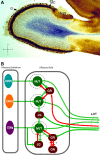


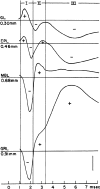



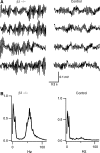
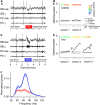
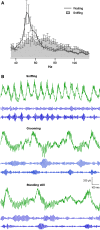
Similar articles
-
Gamma and Beta Oscillations Define a Sequence of Neurocognitive Modes Present in Odor Processing.J Neurosci. 2016 Jul 20;36(29):7750-67. doi: 10.1523/JNEUROSCI.0569-16.2016. J Neurosci. 2016. PMID: 27445151 Free PMC article.
-
Beta and gamma oscillatory activities associated with olfactory memory tasks: different rhythms for different functional networks?Front Behav Neurosci. 2014 Jun 23;8:218. doi: 10.3389/fnbeh.2014.00218. eCollection 2014. Front Behav Neurosci. 2014. PMID: 25002840 Free PMC article. Review.
-
Sniff rhythm-paced fast and slow gamma-oscillations in the olfactory bulb: relation to tufted and mitral cells and behavioral states.J Neurophysiol. 2013 Oct;110(7):1593-9. doi: 10.1152/jn.00379.2013. Epub 2013 Jul 17. J Neurophysiol. 2013. PMID: 23864376
-
Strong coupling between pyramidal cell activity and network oscillations in the olfactory cortex.Neuroscience. 2008 Oct 15;156(3):781-7. doi: 10.1016/j.neuroscience.2008.07.077. Epub 2008 Aug 22. Neuroscience. 2008. PMID: 18790020
-
Circuit oscillations in odor perception and memory.Prog Brain Res. 2014;208:223-51. doi: 10.1016/B978-0-444-63350-7.00009-7. Prog Brain Res. 2014. PMID: 24767485 Review.
Cited by
-
Network mechanism for insect olfaction.Cogn Neurodyn. 2021 Feb;15(1):103-129. doi: 10.1007/s11571-020-09640-3. Epub 2021 Jan 15. Cogn Neurodyn. 2021. PMID: 33786083 Free PMC article.
-
Olfactory oscillations: the what, how and what for.Trends Neurosci. 2009 Apr;32(4):207-14. doi: 10.1016/j.tins.2008.11.008. Epub 2009 Feb 23. Trends Neurosci. 2009. PMID: 19243843 Free PMC article. Review.
-
Smell-induced gamma oscillations in human olfactory cortex are required for accurate perception of odor identity.PLoS Biol. 2022 Jan 5;20(1):e3001509. doi: 10.1371/journal.pbio.3001509. eCollection 2022 Jan. PLoS Biol. 2022. PMID: 34986157 Free PMC article.
-
Synchronization of neuron population subject to steady DC electric field induced by magnetic stimulation.Cogn Neurodyn. 2013 Jun;7(3):237-52. doi: 10.1007/s11571-012-9233-x. Epub 2012 Dec 12. Cogn Neurodyn. 2013. PMID: 24427204 Free PMC article.
-
The spiking output of the mouse olfactory bulb encodes large-scale temporal features of natural odor environments.bioRxiv [Preprint]. 2024 Jul 1:2024.03.01.582978. doi: 10.1101/2024.03.01.582978. bioRxiv. 2024. PMID: 38496526 Free PMC article. Preprint.
References
-
- None
- Acheson D (1997) From calculus to chaos. An introduction to dynamics. Oxford University Press, Oxford
-
- {'text': '', 'ref_index': 1, 'ids': [{'type': 'PMC', 'value': 'PMC1393326', 'is_inner': False, 'url': 'https://pmc.ncbi.nlm.nih.gov/articles/PMC1393326/'}, {'type': 'PubMed', 'value': '16991539', 'is_inner': True, 'url': 'https://pubmed.ncbi.nlm.nih.gov/16991539/'}]}
- Adrian ED (1942) Olfactory reactions in the brain of the hedgehog. J Physiol 100:459–473 - PMC - PubMed
-
- {'text': '', 'ref_index': 1, 'ids': [{'type': 'DOI', 'value': '10.1016/0013-4694(50)90075-7', 'is_inner': False, 'url': 'https://doi.org/10.1016/0013-4694(50)90075-7'}, {'type': 'PubMed', 'value': '14793507', 'is_inner': True, 'url': 'https://pubmed.ncbi.nlm.nih.gov/14793507/'}]}
- Adrian ED (1950) The electrical activity of the mammalian olfactory bulb. Electroencephalogr Clin Neurophysiol 2:377–388 - PubMed
-
- {'text': '', 'ref_index': 1, 'ids': [{'type': 'DOI', 'value': '10.1038/nature02185', 'is_inner': False, 'url': 'https://doi.org/10.1038/nature02185'}, {'type': 'PubMed', 'value': '14668854', 'is_inner': True, 'url': 'https://pubmed.ncbi.nlm.nih.gov/14668854/'}]}
- Aungst JL, Heyward PM, Puche AC, Karnup SV, Hayar A, Szabo G, Shipley MT (2003) Centre-surround inhibition among olfactory bulb glomeruli. Nature 426:623–629 - PubMed
-
- {'text': '', 'ref_index': 1, 'ids': [{'type': 'DOI', 'value': '10.1007/BF00289236', 'is_inner': False, 'url': 'https://doi.org/10.1007/bf00289236'}, {'type': 'PubMed', 'value': '4663626', 'is_inner': True, 'url': 'https://pubmed.ncbi.nlm.nih.gov/4663626/'}]}
- Basar E, Ozesmi C (1972) The hippocampal EEG-activity and a systems analytical interpretation of averaged evoked potentials of the brain. Kybernetik 12:45–54 - PubMed
Grants and funding
LinkOut - more resources
Full Text Sources
Research Materials

